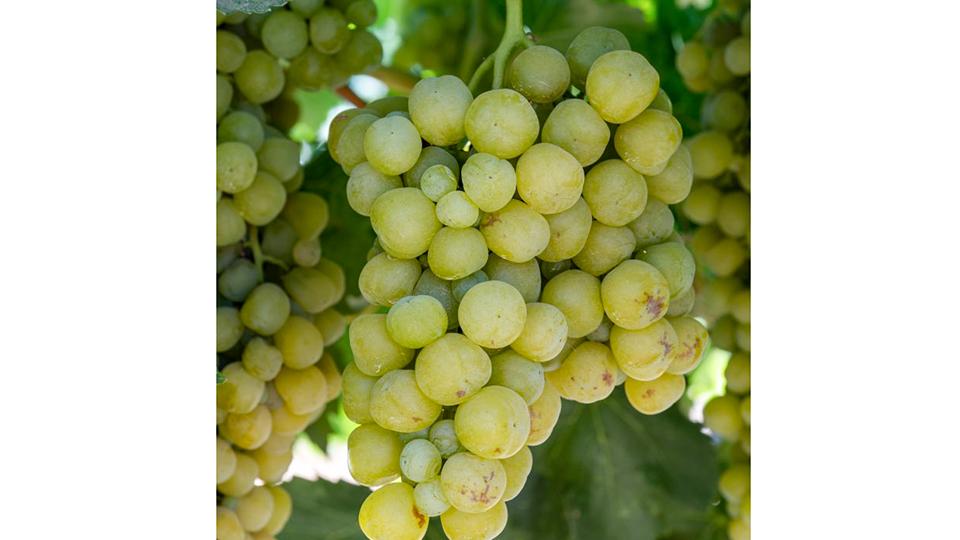How To Increase Your Yield of Natural Dry-On-Vine Raisins

‘Sunpreme’ was the first of a new generation of “natural” dry-on-vine (DOV) raisin grape varieties released in 2015. The grapes of natural DOV raisins dry spontaneously after ripening with no cane severance or other intervention needed.
Photo by Matthew Fidelibus, UC Davis.
Most California raisins are dried in vineyards on paper “trays” laid on the ground between vine rows. Traditionally, grapes were picked and placed on trays by hand, but today it’s more common for growers to use a mechanical harvester and tray layer.
Mechanization of harvest, drying, and pick-up operations reduces the need for labor associated with tray drying and, therefore, reduces raisin production costs. However, the ongoing need for the trays to be placed in a sunlit space between vine rows constrains row spacing and/or trellis size, which limits yield potential.
The first generation of dry-on-vine (DOV) raisin varieties, released by USDA approximately 30 years ago, enabled growers to adopt new cultural practices and vineyard designs that simultaneously reduced production costs and increased yield potential.
In DOV vineyards, canes bearing ripe fruit are severed, causing the grapes to DOV, rather than the ground, and they are harvested by machine. No vineyard space is needed for trays, so larger trellises, which increase yield potential, can be used. However, the first DOV varieties required cane pruning to maximize yield potential and allow for cane severance, which is necessary to initiate drying in those varieties.
Cane pruning is more laborious and expensive than spur pruning and not easily mechanized. In 2015 ‘Sunpreme’, the first of a new generation of “natural” DOV raisin grapes, was released. The grapes of natural DOV raisins dry spontaneously after ripening; no cane severance or other intervention is needed. This variety is also very fruitful on basal buds and can be spur or machine pruned. The combination of natural drying and machine pruning offers the potential to completely mechanize cultural practices, a major advancement in raisin production.
Unfortunately, ‘Sunpreme’ also has some undesirable traits, the most significant of which is preharvest fruit drop. Another concern is the physiological basis for the natural drying trait is not well understood, and growers have less control over the drying process. In other varieties, grape soluble solids content at drying initiation is an important management consideration, affecting raisin yield and quality. The timing of drying initiation can also have a major impact on the timeliness of drying, which can reduce the risk of drying grapes being exposed to rain.
MULTI-YEAR STUDY RESULTS
To better understand how some basic cultural practices, including rootstock (Freedom, 1103P, or own-rooted), trellis (two-wire T trellis or high single-wire), and nitrogen (N) fertilizer rates (40 versus 80 pounds N/acre) may affect preharvest fruit drop, and raisin yield and quality, including moisture content, a multi-year study was initiated.
The study began in 2021, the first crop year. Preharvest fruit drop was approximately 25% and not affected by any treatments. Own-rooted vines had bigger berries with less soluble solids than vines on rootstocks, and lower raisin yields (1.48 tons/acre own-rooted, versus 1.89 or 1.69 tons/acre for vines on 1103P or Freedom, respectively).
Vines on the high single-wire trellis had larger berries but similar raisin yield and quality as vines on T-trellises. None of the treatments affected ‘B and better’ raisin grades, which were between 82% and 86%. In the second year of the study, preharvest drop decreased to approximately 10% and was not affected by any of the treatments. Yields increased substantially across the board, though own-rooted vines once again had the lowest yields (3.59 tons/acre), followed by 1103P (3.76 tons/acre) and Freedom (3.83 tons/acre).
However, raisin quality was somewhat lower in 2022 versus 2021, and vines on Freedom had the lowest percent ‘B and better’ (62%); vines on 1003P and own-rooted vines had the same grades (70% ‘B and better’). Vines on T-trellises had approximately 8% greater yields than vines on bilateral trellises, and doubling the N application rate, from 40 to 80 pounds/acre, only increased yield by 5%. Results to date suggest rootstocks, larger trellises, and more nitrogen may each modestly increase raisin yield of natural DOV varieties.
Final management recommendations will be made after additional data are collected and an economic analysis is conducted.










